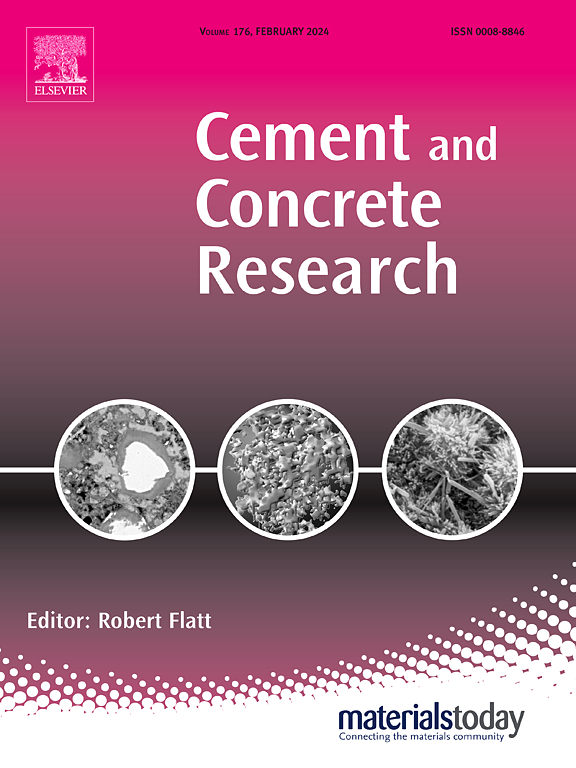Deriving early hydration cement paste phase assemblage, microstructure development and elastic properties using thermodynamic simulation and multi-scale material modeling
IF 13.1
1区 工程技术
Q1 CONSTRUCTION & BUILDING TECHNOLOGY
引用次数: 0
Abstract
Many hydration models focus on predicting the long-term hydration process and resulting material changes without specifically addressing early hydration within the first day. Here, we present a new approach for predicting early hydration cement paste phase assemblage, microstructure development and elastic properties by applying thermodynamic modeling and simulation as input to a multi-scale material model. Cement dissolution for implementation within the thermodynamic simulation is derived by fitting the five-parameter logistic function (5PL) to experimental data from quantitative X-ray diffraction. Results are compared with simulations using the modified Parrot & Killoh model for cement dissolution. Further, the influence of variations in the calcium sulphate and calcite content of the initial cement phase assemblage is investigated accounting for errors in experimental determination. The proposed model for hydrating cement paste accounts for all phases predicted by the thermodynamic simulation output, two types of C-S-H, as well as concentric growth of hydrates from the surface of the clinker grains. The stiffness of the hydrating cement paste is derived by upscaling the microscopic properties using a multi-level continuum micromechanics homogenization scheme. Model predictions are compared with experimental results from penetration tests and ultrasonic Young’s modulus determination.
It is shown, that 5PL dissolution modeling in combination with thermodynamic simulation is able to describe early hydration cement phase alterations. The 5PL approach thereby captures initial ettringite formation and accurately describes portlandite precipitation. However, the results are highly dependent on the quality of the experimental data. The results further illustrate, how cement paste stiffness development can be derived by application of low-cost computational methods. The proposed approach enables investigations of state-of-the-art questions of cement hydration including the influence of individual hydrate phases on the solidification process.

利用热力学模拟和多尺度材料模型推导水泥浆体早期水化相组合、微观结构发展和弹性性能
许多水化模型侧重于预测长期水化过程和由此产生的材料变化,而没有具体解决第一天内的早期水化问题。在这里,我们提出了一种新的方法来预测早期水化水泥膏体相组合、微观结构发展和弹性性能,将热力学建模和模拟作为多尺度材料模型的输入。水泥溶解在热力学模拟中的实现是通过将五参数逻辑函数(5PL)拟合到定量x射线衍射的实验数据中得出的。结果与使用改进的Parrot &;水泥溶解的Killoh模型。此外,考虑到实验测定中的误差,研究了初始水泥相组合中硫酸钙和方解石含量变化的影响。所提出的水泥浆体水化模型考虑了热力学模拟输出预测的所有相、两种类型的C-S-H以及熟料颗粒表面水化物的同心生长。水化水泥浆体的刚度是通过采用多级连续体细观力学均质方案来提高微观特性来推导的。将模型预测结果与侵彻试验结果和超声杨氏模量测定结果进行了比较。结果表明,5PL溶解模型结合热力学模拟能够描述早期水化水泥相变化。因此,5PL方法捕获了初始钙矾石的形成,并准确地描述了波特兰岩的降水。然而,结果在很大程度上取决于实验数据的质量。结果进一步说明,如何通过应用低成本的计算方法来推导水泥浆体的刚度发展。所提出的方法能够研究水泥水化的最新问题,包括单个水合物相对固化过程的影响。
本文章由计算机程序翻译,如有差异,请以英文原文为准。
求助全文
约1分钟内获得全文
求助全文
来源期刊

Cement and Concrete Research
工程技术-材料科学:综合
CiteScore
20.90
自引率
12.30%
发文量
318
审稿时长
53 days
期刊介绍:
Cement and Concrete Research is dedicated to publishing top-notch research on the materials science and engineering of cement, cement composites, mortars, concrete, and related materials incorporating cement or other mineral binders. The journal prioritizes reporting significant findings in research on the properties and performance of cementitious materials. It also covers novel experimental techniques, the latest analytical and modeling methods, examination and diagnosis of actual cement and concrete structures, and the exploration of potential improvements in materials.
 求助内容:
求助内容: 应助结果提醒方式:
应助结果提醒方式:


